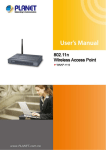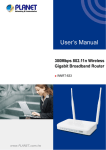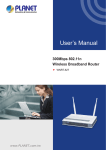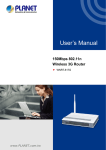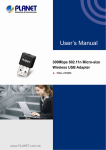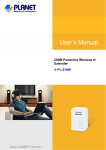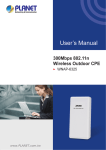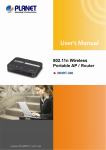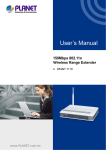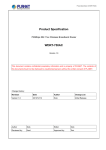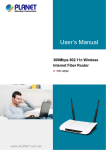Download User Manual - PLANET Technology Corporation.
Transcript
Copyright
Copyright 2013 by PLANET Technology Corp. All rights reserved. No part of this publication may be
reproduced, transmitted, transcribed, stored in a retrieval system, or translated into any language or computer
language, in any form or by any means, electronic, mechanical, magnetic, optical, chemical, manual or
otherwise, without the prior written permission of PLANET.
PLANET makes no representations or warranties, either expressed or implied, with respect to the contents
hereof and specifically disclaims any warranties, merchantability or fitness for any particular purpose.
Any
software described in this manual is sold or licensed "as is". Should the programs prove defective following their
purchase, the buyer (and not this company, its distributor, or its dealer) assumes the entire cost of all necessary
servicing, repair, and any incidental or consequential damages resulting from any defect in the software. Further,
this company reserves the right to revise this publication and to make changes from time to time in the contents
hereof without obligation to notify any person of such revision or changes.
All brand and product names mentioned in this manual are trademarks and/or registered trademarks of their
respective holders.
Federal Communication Commission Interference Statement
This equipment has been tested and found to comply with the limits for a Class B digital device, pursuant to Part
15 of FCC Rules. These limits are designed to provide reasonable protection against harmful
interference in a residential installation. This equipment generates, uses, and can radiate radio
frequency energy and, if not installed and used in accordance with the instructions, may cause
harmful interference to radio communications. However, there is no guarantee that interference will not occur in
a particular installation. If this equipment does cause harmful interference to radio or television reception, which
can be determined by turning the equipment off and on, the user is encouraged to try to correct the interference
by one or more of the following measures:
1. Reorient or relocate the receiving antenna.
2. Increase the separation between the equipment and receiver.
3.
Connect the equipment into an outlet on a circuit different from that to which the receiver is connected.
4. Consult the dealer or an experienced radio technician for help.
FCC Caution:
To assure continued compliance, (example-use only shielded interface cables when connecting to computer or
peripheral devices) any changes or modifications not expressly approved by the party responsible for
compliance could void the user’s authority to operate the equipment.
This device complies with Part 15 of the FCC Rules. Operation is subject to the Following two conditions:
(1) This device may not cause harmful interference
(2) This Device must accept any interference received, including interference that may cause undesired
operation.
Any changes or modifications not expressly approved by the party responsible for compliance could
void the user’s authority to operate the equipment.
I
Federal Communication Commission (FCC) Radiation Exposure Statement
This equipment complies with FCC radiation exposure set forth for an uncontrolled environment. In order to
avoid the possibility of exceeding the FCC radio frequency exposure limits, human proximity to the antenna
shall not be less than 20 cm (8 inches) during normal operation.
R&TTE Compliance Statement
This equipment complies with all the requirements of DIRECTIVE 1999/5/CE OF THE EUROPEAN
PARLIAMENT AND THE COUNCIL OF 9 March 1999 on radio equipment and telecommunication terminal
Equipment and the mutual recognition of their conformity (R&TTE).
The R&TTE Directive repeals and replaces in the directive 98/13/EEC (Telecommunications Terminal
Equipment and Satellite Earth Station Equipment) As of April 8, 2000.
Safety
This equipment is designed with the utmost care for the safety of those who install and use it. However, special
attention must be paid to the dangers of electric shock and static electricity when working with electrical
equipment. All guidelines of this and of the computer manufacture must therefore be allowed at all times to
ensure the safe use of the equipment.
National Restrictions
This device is intended for home and office use in all EU countries (and other countries following the EU
directive 1999/5/EC) without any limitation except for the countries mentioned below:
Country
Restriction
Bulgaria
None
France
Reason/remark
General authorization required for outdoor use and
public service
Outdoor use limited to 10
Military Radiolocation use. Refarming of the 2.4 GHz
mW e.i.r.p. within the band
band has been ongoing in recent years to allow current
2454-2483.5 MHz
relaxed regulation. Full implementation planned 2012
Italy
None
Luxembourg
None
Norway
Implemented
Russian
None
If used outside of own premises, general authorization is
required
General authorization required for network and service
supply(not for spectrum)
This subsection does not apply for the geographical area
within a radius of 20 km from the centre of Ny-Ålesund
Only for indoor applications
Federation
Note: Please don’t use the product outdoors in France.
WEEE regulation
To avoid the potential effects on the environment and human health as a result of the presence of
hazardous substances in electrical and electronic equipment, end users of electrical and electronic
equipment should understand the meaning of the crossed-out wheeled bin symbol. Do not dispose of
WEEE as unsorted municipal waste and have to collect such WEEE separately.
II
Revision
User Manual for PLANET 300Mbps Dual Band 802.11n Wireless Gigabit Router
Model: WDRT-731U
Rev: 1.0 (January, 2013)
Part No. EM-WDRT731U_v1.01 (2081-E50280-001)
III
CONTENTS
Chapter 1.Product Introduction...........................................................................................................1
1.1
Package Contents ...............................................................................................................1
1.2
Product Description............................................................................................................2
1.3
Product Features................................................................................................................. 5
1.4
Product Specification ......................................................................................................... 6
Chapter 2.Hardware Installation ..........................................................................................................8
2.1
Hardware Description ......................................................................................................... 8
2.1.1
The Front Panel ........................................................................................................ 9
2.1.2
LED Indications......................................................................................................... 9
2.1.3
The Rear Panel.......................................................................................................10
2.1.4
The Right Side Panel.............................................................................................. 11
Chapter 3.Connecting to the Router .................................................................................................12
3.1
System Requirements ......................................................................................................12
3.2
Installing the Router..........................................................................................................12
Chapter 4.Quick Installation Guide ...................................................................................................14
4.1
4.2
Manual Network Setup - TCP/IP Configuration ..............................................................14
4.1.1
Obtain an IP Address Automatically........................................................................14
4.1.2
Configure the IP Address Manually ........................................................................16
Starting Setup in the Web UI ............................................................................................20
Chapter 5.Configuring the Router .....................................................................................................23
5.1
Device Info .........................................................................................................................23
5.2
Network ..............................................................................................................................28
5.3
5.4
5.2.1
LAN Settings...........................................................................................................28
5.2.2
WAN Settings..........................................................................................................29
5.2.3
DHCP Settings........................................................................................................36
5.2.4
WAN Port ................................................................................................................38
Security Settings...............................................................................................................41
5.3.1
Group Settings........................................................................................................41
5.3.2
Port Filter ................................................................................................................44
5.3.3
URL Filter................................................................................................................47
5.3.4
MAC Address Filter.................................................................................................50
5.3.5
WAN Access Control...............................................................................................52
Advanced Settings............................................................................................................54
5.4.1
Virtual Server ..........................................................................................................54
5.4.2
DMZ Settings ..........................................................................................................56
5.4.3
UPnP Settings ........................................................................................................57
5.4.4
Routing....................................................................................................................58
5.4.5
Bandwidth Control ..................................................................................................59
IV
5.5
5.6
Wireless Settings ..............................................................................................................62
5.5.1
Basic Settings .........................................................................................................62
5.5.2
Wireless Security ....................................................................................................65
5.5.3
WPS Settings..........................................................................................................68
5.5.4
WDS Settings .........................................................................................................70
5.5.5
Guest Network ........................................................................................................73
5.5.6
Wireless Access Control .........................................................................................74
5.5.7
Connection Status...................................................................................................76
5.5.8
Wireless –Advance Settings...................................................................................76
USB Applications ..............................................................................................................78
5.6.1
USB Storage ...........................................................................................................78
5.6.2
Printing Service.......................................................................................................81
5.7
IPTV Settings .....................................................................................................................98
5.8
Tools .................................................................................................................................100
5.8.1
Time Settings ........................................................................................................100
5.8.2
Firmware Upgrade ................................................................................................101
5.8.3
Backup/Restore Settings ......................................................................................102
5.8.4
Restore to Factory Default Settings......................................................................102
5.8.5
Change Password/User Name .............................................................................103
5.8.6
Reboot ..................................................................................................................104
5.8.7
Statistics................................................................................................................105
5.8.8
Syslog ...................................................................................................................105
Chapter 6.Quick Connection to a Wireless Network .....................................................................107
6.1
Windows XP (Wireless Zero Configuration).................................................................107
6.2
Windows 7 (WLAN AutoConfig).....................................................................................109
6.3
Mac OS X 10.x.................................................................................................................. 111
6.4
iPhone / iPod Touch / iPad ............................................................................................. 113
Appendix A: Troubleshooting.......................................................................................................... 116
Appendix B: Configuring the PC in Windows 7 ............................................................................. 118
Appendix C: Specifications..............................................................................................................122
Appendix D: Glossary.......................................................................................................................124
V
User Manual of WDRT-731U
Chapter 1. Product Introduction
1.1 Package Contents
Thank you for choosing PLANET WDRT-731U. Before installing the router, please verify the contents inside the
package box.
WDRT-731U Wireless Router
Quick Installation Guide
CD-ROM
(User Manual included)
Power Adapter
12V/1A DC output
100~240V AC input
Ethernet Cable
RJ-45 / CAT5E 1 meter UTP
If there is any item missed or damaged, please contact the seller
immediately.
-1-
User Manual of WDRT-731U
1.2 Product Description
2.4G & 5G Simultaneous Dual Band Wireless Connectivity
Since there are more and more wireless applications and electric devices using the radio frequency of 2.4GHz,
the wireless channel of 2.4GHz has been already too crowded for clients to enjoy the high-speed wireless
connection. In order to avoid the wireless interference between each other, PLANET WDRT-731U provides
users the radio frequency of 5GHz for watching HD videos or playing online games additionally. At the same
time, it enables other users still surf the Internet via the original radio frequency of 2.4 GHz. The WDRT-731U is
just like 2 totally independent Access Points in one device for you.
-2-
User Manual of WDRT-731U
Multiple Network Technologies for Incredibly 600Mbps High-Speed Connection
The WDRT-731U supports IEEE 802.11a/b/g/n Dual Band standard with 2T2R antenna technology, therefore it
can provide the wireless speed up to 300 + 300Mbps which is 12 times faster than that of traditional 11g Access
Point. Moreover, the WDRT-731U is equipped with all Gigabit Ethernet Ports. Compared with general wireless
routers, the WDRT-731U offers faster transmitting speed and more convenient method to enable or disable
wireless signal.
Fully Support of Wireless Security Encryption
To secure the wireless communication, the WDRT-731U supports up-to-date encryption technology, WPA /
WPA2 and WPA-PSK / WPA2-PSK with TKIP/AES. The WDRT-731U supports Wi-Fi Protected Setup (WPS)
configuration with PBC/PIN methods to simplify the wireless security settings. By just clicking the WPS button,
the secure connection between the wireless AP and wireless client will be built immediately.
IPTV Pass-through for Video On Demand
The WDRT-731U provides an IPTV-specific port which enables the IPTV Set-Top-Box (STB) connection directly
by passing through the LAN port. The IPTV feature makes it possible for users to enjoy online videos on the TV
set via Set-Top-Box (STB) through the WDRT-731U while surfing Internet. The IPTV port can also function as a
LAN port if IPTV service is not enabled.
More Flexible File Sharing over USB port
The WDRT-731U is built-in with one USB 2.0 port which can be connected to a USB printer or storage device for
file sharing. It can recognize the USB printer or storage automatically without user experience. Thus, all clients
on the network can share printer or mass storage through the WDRT-731U without complicated network
configuration. Via the USB port, it also can output 5V DC power to charge any USB compliant devices.
-3-
User Manual of WDRT-731U
Powerful Firewall and Complete Access Control Functions
The WDRT-731U supports NAT function allowing multiple users to access Internet via a single legal IP.
It also
provides Virtual Server for the specific LAN PC to act as an application server and offer certain service to the
clients on the Internet. In addition, the powerful firewall protects your Intranet clients from unauthorized accesses
and various kinds of DoS attacks from the Internet. In the aspect of firewall, the WDRT-731U supplies IP-based
and MAC-based access control to prevent possible hackers attack.
Easy Setup for Multiple Wireless Modes
The WDRT-731U supports multiple wireless modes including AP, Wireless Bridge, and Repeater, for different
network applications. Furthermore, with the built-in Quick Setup function, users can configure the WDRT-731U
easily and quickly through a couple of simple steps. It is so easy to apply the WDRT-731U to the existing wired
network. The WDRT-731U definitely provides a total network solution for the home and the SOHO users.
-4-
User Manual of WDRT-731U
Wireless Coverage Plus !
The WDRT-731U is equipped with 5dBi High-Gain antennas to provide strong signal and excellent performance
even in the long range or bad environment. Besides essential wireless sharing for Wi-Fi clients, the WDRT-731U
provides WDS (Wireless Distribution System) bridge mode to facilitate wireless network deployments and
range expanding. It provides more flexibility for users while establishing wireless network.
1.3 Product Features
IEEE Compliant Wireless LAN & Wired LAN
Compliant with IEEE 802.11a/b/g/n dual-band (2.4G&5G) wireless technology capable up to
300+300Mbps data rate
Equipped with all Gigabit RJ-45 ports (10/100/1000Mbps) of 1 WAN and 4 LAN ports
Auto MDI/MDI-X supported
LAN4 supports IPTV Pass-through enables you enjoy online videos
Fixed-network Broadband Router
Supported WAN connection types: Dynamic IP/ Static IP / PPPoE / PPTP / L2TP / PPPoE Dual
Access
Supports Dynamic DNS and DHCP Server
Secure Network Connection
Supports Wi-Fi Protected Setup (WPS)
Advanced security: 64/128-bit WEP, WPA/WPA2 and WPA-PSK/WPA2-PSK (TKIP/AES
encryption)
Supports NAT firewall, IP / Port / URL-based access control and MAC address Filtering
Support Dual-SSID to allow users to access different networks through a single AP
Advanced Networking function for Specific Application
Supports Bandwidth Control (QoS) based on different local IP addresses
Supports NTP, Virtual Server, UPnP, and DMZ for various networking applications
Equipped with one USB port for sharing printers and USB mass storages wirelessly
Easy Installation & Management
User Friendly Web-based UI with On-line Help
Remote Management allows configuration from a remote site
System status monitoring includes DHCP Client List and System Log
-5-
User Manual of WDRT-731U
1.4 Product Specification
Product
WDRT-731U
300Mbps Dual-Band 802.11n Wireless Gigabit Router
Hardware Specification
Interface
Antenna
WAN Port:
1 x 10/100/1000Mbps Auto MDI/MDI-X RJ45 port
LAN Port:
3 x 10/100/1000Mbps Auto MDI/MDI-X RJ45 ports (LAN1~3)
IPTV Port:
1 x 10/100/1000Mbps Auto MDI/MDI-X RJ45 port (LAN4)
USB Port :
USB 2.0, Type-A, 5V DC/0.5A Output
Gain:
2 x 5dBi fixed antenna
Orientation:
Omni-directional
Reset / WPS button at rear panel
Reset / WPS Button
Press for about 7 seconds to reset the device to factory default.
Press for 1 second to activate WPS function.
PWR/SYS, WLAN (2.4G & 5G) x 2
WAN (Link & 1000Mbps) x 1
LED Indicators
LAN (Link & 1000Mbps) x 3
IPTV (Link & 1000Mbps) x 1
USB, WPS
Material
Plastic
Dimension (WxDxH)
171.61 x 111.16 x 25.47 mm (W x D x H)
Weight
250g
Power Requirement
12V DC, 1A
Wireless interface Specification
Standard
Compliance with IEEE 802.11a/b/g/n
Simultaneous 2.4 GHz and 5 GHz
Frequency Band
2.4GHz: 2.412~2.484GHz
5GHz: 5.180~5.825GHz
Transmission
Indoor up to 100m
Distance
Outdoor up to 300m (it is limited to the environment)
5GHz:
2.4GHz:
RF Power
11b: 17±1dBm
11a: 12±1.5dBm
(Intentional Radiator)
11g: 14.5±1.5dBm
11n: 12±1.5dBm
11n: 12.5±1.5dBm
Wireless Management Features
Wireless Modes
AP
WDS PtP
WDS PtMP
-6-
User Manual of WDRT-731U
Encryption Security
WEP (64/128-bit)
WPA-PSK (TKIP) / WPA2-PSK (AES)
WPA (TKIP) / WPA2 (AES)
Provide Wireless LAN ACL (Access Control List) filtering
Wireless Security
Wireless MAC address filtering
Support WPS (WIFI Protected Setup )
Support Dual-SSID (2.4G & 5G)
Wireless Advanced
AP Isolation: Enable it to isolate each connected wireless clients, to let them
cannot access mutually.
Support 802.11e WMM (Wi-Fi Multimedia)
Max. Supported
Wire: 15
Clients
Wireless: 10
Router Features
Shares data and Internet access for users, supporting following internet
access:
Dynamic IP
Internet Connection
Static IP
Type
PPPoE
PPTP
L2TP
PPPoE Dual Access
NAT firewall
Firewall
Built-in NAT server which supports Virtual Server, and DMZ
Built-in firewall with IP address filtering, Port filtering, URL filtering, and MAC
address filtering
Routing Protocol
Static Routing
Built-in DHCP server supporting static IP address distributing
Support UPnP, Dynamic DNS
LAN
Support Packets Statistics
IP-based Bandwidth Control
Session Number: Max. 8000
Web-based (HTTP) management interface
System Management
Remote management (WAN Access Control)
SNTP time synchronize
System Log
Windows 7
OS Compatibility
Windows Vista
Windows XP
Mac OS X 10.4 and higher
-7-
User Manual of WDRT-731U
Chapter 2. Hardware Installation
Please follow the instructions below to connect WDRT-731U to the existing network devices and your computers.
2.1 Hardware Description
Dimension: 171.61 x 111.16 x 25.47mm (W x D x H)
Diagram :
Figure 2-1
-8-
User Manual of WDRT-731U
2.1.1 The Front Panel
The front panel provides a simple interface monitoring the router. Figure 2-2 shows the front panel of
WDRT-731U.
Front Panel
Figure 2-2 WDRT-731U Front Panel
2.1.2 LED Indications
The LEDs on the front panel indicate instant status of port links, wireless data activity, system power; and help
monitor and troubleshoot when needed. Figure 2-2 and Table 2-1 show the LED indications of the Wireless
Router.
LED Definition
Figure 2-3 WDRT-731U Front Panel
LED
(Left to Right)
PWR
STATE
FUNCTION
On
Device power on
Flash
The system is working properly
Off
Device power off
-9-
User Manual of WDRT-731U
WPS
5G
2.4G
LAN
1~4
WAN
USB
Flash
The system is performing WPS authentication on a client
device.
On
The 5G WiFi is activated
Flash
Device is transmitting data wirelessly over 5GHz
On
The 2.4G WiFi is activated
Flash
Device is transmitting data wirelessly over 2.4GHz
On
Link is established
Flash
Packets are transmitting or receiving
Off
LAN port is not connected
On
Link is established
Flash
Packets are transmitting or receiving
Off
WAN port is not connected
On
The USB port is correctly connected
Off
The USB port is not connected
Table 2-1 The LEDs indication
2.1.3 The Rear Panel
The rear panel provides the physical connectors connected to the power adapter and any other network devices.
Figure 2-3 shows the rear panel of WDRT-731U.
Rear Panel
Figure 2-4 Rear Panel of WDRT-731U
-10-
User Manual of WDRT-731U
Interface
Antenna x 2
Description
Fixed Dual-Band 5dBi Omni Dipole Antennas
Press the Reset button gently for 1 second and then release it. The
system starts to WPS connection.
WPS/Reset
Press the Reset button gently for 7 seconds and then release it. The
system restores to the factory default settings.
WAN
Connect to the Cable/xDSL Modem, or the Ethernet
LAN1-4
Connect to the user’s PC or network devices
Power
Connect to the power adapter provided in the package
Table 2-2 The Interface indication
2.1.4 The Right Side Panel
WDRT-731U built-in with one USB 2.0 port can be connected to a USB printer or storage for file sharing. The
USB port also output 5V DC power can charge any USB compliant devices.
Right Side Panel
Figure 2-5 USB port of WDRT-731U
-11-
User Manual of WDRT-731U
Chapter 3. Connecting to the Router
3.1 System Requirements
Broadband Internet Access Service (Cable/xDSL/Ethernet connection)
One Cable/xDSL Modem that has an RJ-45 connector (not necessary if the Router is connected
directly to the Ethernet.)
PCs with a working Ethernet Adapter and an Ethernet cable with RJ-45 connectors
PC of subscribers running Windows 98/ME, NT4.0, 2000/XP, Windows Vista / Win 7, MAC OS 9 or
later, Linux, UNIX or other platform compatible with TCP/IP protocols
Above PC installed with WEB Browser
1. The Router in the following instructions means PLANET WDRT-731U.
2. It is recommended to use Internet Explore 7.0 or above to access the Router.
3.2 Installing the Router
Before installing the Router, make sure your PC is connected to the Internet through the broadband service
successfully at this moment. If there is any problem, please contact your local ISP. After that, please install the
Router according to the following steps. Don't forget to pull out the power plug and keep your hands dry.
Step 1. Power off your PC, Cable/xDSL Modem, and the Router.
Step 2. Locate an optimum location for the Router. The best place is usually at the center of your wireless
network.
Step 3. Adjust the direction of the antenna. Normally, upright is a good direction.
Step 4. Connect the PC or Switch/Hub in your LAN to the LAN Ports (Yellow ports) of the Router with Ethernet
cable, shown in Figure 3-1.
-12-
User Manual of WDRT-731U
Figure 3-1 Hardware Installation of the WDRT-731U Wireless Router
Step 5. Connect the power adapter to the power socket on the Router, and the other end into an electrical
outlet. Then power on the Router.
Step 6. Power on your PC and Cable/xDSL Modem.
-13-
User Manual of WDRT-731U
Chapter 4. Quick Installation Guide
This chapter will show you how to configure the basic functions of your Wireless Router using Quick Setup
within minutes.
A computer with wired Ethernet connection to the Wireless Router is required for the
first-time configuration.
4.1 Manual Network Setup - TCP/IP Configuration
The default IP address of the WDRT-731U is 192.168.1.1. And the default Subnet Mask is 255.255.255.0. These
values can be changed as you desire. In this guide, we use all the default values for description.
Connect the local PC to the LAN ports of the Router. And then you can configure the IP address for your PC in
the following two ways.
Obtain an IP address automatically
Configure the IP address manually
In the following sections, we’ll introduce how to install and configure the TCP/IP correctly in Windows XP. And
the procedures in other operating systems are similar. First, make sure your Ethernet Adapter is working, and
refer to the Ethernet adapter’s manual if needed.
4.1.1 Obtain an IP Address Automatically
Summary:
1.
1.
Set up the TCP/IP Protocol in "Obtain an IP address automatically" mode on your PC.
2.
Then the WDRT-731U built-in DHCP server will assign IP address to the PC automatically.
Install TCP/IP component
1)
On the Windows taskbar, click the Start button, point to Settings, and then click Control Panel.
2)
Click the Network and Internet Connections icon, and then click on the Network Connections tab in
the appearing window.
3)
Right click the icon shown below, select Properties on the prompt window.
-14-
User Manual of WDRT-731U
Figure 4-1
4)
In the prompt window shown below, double click on the Internet Protocol (TCP/IP).
Figure 4-2
5)
The following TCP/IP Properties window will display and the IP Address tab is open on this window
by default.
-15-
User Manual of WDRT-731U
2.
Setting IP address automatically
Select Obtain an IP address automatically, Choose Obtain DNS server automatically, as shown in the
Figure below:
Figure 4-3
Now click OK to save your settings.
4.1.2 Configure the IP Address Manually
Summary:
Set up the TCP/IP Protocol for your PC.
Configure the network parameters. The IP address is 192.168.1.xxx ("xxx" is any number from 2 to
254), Subnet Mask is 255.255.255.0, and Gateway is 192.168.1.1 (The Router's default IP address)
1
Select Use the following IP address radio button.
2
If the Router's LAN IP address is 192.168.1.1, enter IP address 192.168.1.x (x is from 2 to 254), and
Subnet mask 255.255.255.0.
3
Enter the Router’s LAN IP address (the default IP is 192.168.1.1) into the Default gateway field.
4
Select Use the following DNS server addresses radio button. In the Preferred DNS Server field, you can
enter the DNS server IP address which has been provided by your ISP
-16-
User Manual of WDRT-731U
Figure 4-4
Now click OK to save your settings.
Now, you can run the Ping command in the command prompt to verify the network connection between your
PC and the Router. The following example is in Windows XP OS. Please follow the steps below:
1.
Click on Start > Run.
Figure 4-5
-17-
User Manual of WDRT-731U
2.
In the run box type “cmd” and click OK. (Windows Vista users type “cmd” in the Start .Search box.)At the
prompt.
Figure 4-6
Open a command prompt, and type ping 192.168.1.1, and then press Enter.
If the result displayed is similar to Figure 4-7, it means the connection between your PC and the
Router has been established well.
Figure 4-7 Success result of Ping command
If the result displayed is similar to Figure 4-8, it means the connection between your PC and the
Router has failed.
-18-
User Manual of WDRT-731U
Figure 4-8 Failure result of Ping command
If the address is 0.0.0.0, check your adapter installation, security settings, and the settings on your router. Some
firewall software programs may block a DHCP request on newly installed adapters.
1. The 1/2/3/4 LEDs of LAN ports which you link to on the Router and LEDs on your
PC's adapter should be lit.
2. If the Router's IP address is 192.168.1.1, your PC's IP address must be within the
range of 192.168.1.2 ~ 192.168.1.254.
-19-
User Manual of WDRT-731U
4.2 Starting Setup in the Web UI
It is easy to configure and manage the WDRT-731U with the web browser.
Step 1.
To access the configuration utility, open a web-browser and enter the default IP address
http://192.168.1.1 in the web address field of the browser.
Figure 4-9 Login the Router
After a moment, a login window will appear. Enter admin for the User Name and Password, both in lower case
letters. Then click the OK button or press the Enter key.
Figure 4-10 Login Window
Default IP Address: 192.168.1.1
Default User name: admin
Default Password: admin
If the above screen does not pop up, it may mean that your web-browser has been set to a
proxy. Go to Tools menu>Internet Options>Connections>LAN Settings, in the screen that
appears, cancel the Using Proxy checkbox, and click OK to finish it.
-20-
User Manual of WDRT-731U
After entering the username and password, the Easy Quick Setup page screen appears as Figure 4-11
Figure 4-11 WDRT-731U Web UI Screenshot
Step 2.
Choose the correct Internet Access method. Please refer to the instructions in the next chapter for
configuring the other Broadband types.
Figure 4-12 Choose Internet Access Method
Step 3. Please enter the User Name, Password and SSID security key and etc. Then click OK button to
make the configuration take effect immediately.
-21-
User Manual of WDRT-731U
Figure 4-13
Step 4. For more detail network setting and functions configuration, you can click the Advanced button to
configure your Router.
Figure 4-14
-22-
User Manual of WDRT-731U
Chapter 5. Configuring the Router
This chapter delivers a detailed presentation of router’s functionalities and features under 8 main menus below,
allowing you to manage the router with ease.
Figure 5-1
During operation, if you are not clear about a certain feature, you can simply click the “Help” button to read all
related helpful info.
5.1 Device Info
In this page, you can view information about the current running status of WDRT-731U, including WAN interface,
LAN interface, Wireless interface settings and status, and firmware version information.
WAN
-23-
User Manual of WDRT-731U
Figure 5-1-1
This section allows you to view the router’s WAN info listed below:
Object
Description
WAN Status:
Displays WAN connection status: Disconnected, Connecting or
Connected.
Disconnected:
Indicates that the Ethernet cable from your ISP side is / is not
correctly connected to the WAN port on the router or the router is not
logically connected to your ISP.
Connecting:
Indicates that the WAN port is correctly connected and is requesting
an IP address from your ISP.
Connected: Indicates that the router has been connected to your
ISP.
Internet
Connection Type:
Displays current Internet connection type.
WAN IP:
Displays WAN IP address.
Subnet Mask:
Displays WAN subnet mask.
Gateway:
Displays WAN gateway address.
DNS Server:
Displays WAN DNS address.
WAN MAC
Address:
Displays router’s WAN MAC address.
WAN Traffic:
Displays bandwidth currently used by router in KB/s.
Connection
Duration:
Displays time duration indicating how long the router has been
connected to ISP.
WAN Traffic Graph:
Displays a graphic presentation of the traffic flow.
-24-
User Manual of WDRT-731U
LAN
This section allows you to view the router’s LAN info listed below:
Figure 5-1-2 LAN Information
The page includes the following fields:
Object
Description
IP Address:
Displays LAN IP address.
Subnet Mask:
Displays LAN subnet mask.
LAN MAC Address:
Displays router’s LAN MAC address.
DHCP Server:
Displays whether DHCP server is enabled or not.
NAT Entries/NAT:
Displays number of used NAT entries and MAX NAT entries.
Wireless
This section allows you to view the wireless info listed below:
-25-
User Manual of WDRT-731U
Figure 5-1-3 Wireless information
The page includes the following fields:
Object
Description
Wireless Radio:
Displays whether wireless is enabled or not.
Wireless MAC
Displays MAC address of the router’s wireless interface
address:
SSID:
Displays current SSID.
802.11 Mode:
Displays currently active network mode.
Country:
Displays current country.
Channel:
Displays current channel.
Security Mode:
Displays current security Mode.
-26-
User Manual of WDRT-731U
System Info
This section displays CPU/memory usage, uptime, system time, number of connected client(s) and system
version info.
Figure 5-1-4 General System information
The page includes the following fields:
Object
Description
CPU Usage:
Displays current CPU usage status
Memory Usage:
Displays current memory usage status.
Up Time:
Displays uptime.
Time:
Displays device’s time synchronized with Internet or manually
set by user.
Connected
Displays the number of connected computers.
Client(s):
Firmware Version:
Displays router’s firmware version.
-27-
User Manual of WDRT-731U
5.2 Network
“Network” includes the following four submenus. Clicking any of them enters corresponding interface for
configuration. Below explains, in details, each such feature.
Figure 5-2-1
5.2.1 LAN Settings
Figure 5-2-2 LAN settings web page screenshot
The page includes the following fields:
Object
Description
IP Address:
Router’s LAN IP.
The default is 192.168.1.1. You can change it according to your
need.
Subnet Mask:
Router’s LAN subnet mask.
If you change the device’s LAN IP address, you must enter the new one in your
browser to get back to the web-based configuration utility. And LAN PCs’ gateway
must be set to this new IP for successful Internet connection.
-28-
User Manual of WDRT-731U
5.2.2 WAN Settings
The screen below displays WAN connection status and interface info.
Figure 5-2-3
Click the “Config” button to enter WAN configuration interface. The router supports six Internet connection types,
include:
Dynamic IP
Static IP
L2TP
PPTP
PPPoE
PPPoE dual access
WAN IP, whether obtained automatically or specified manually, should NOT be on
the same IP net segment as the LAN IP, otherwise, the router will not work
properly. In case of emergency, press the hardware "Reset" button.
Dynamic IP (DHCP)
Select this option to let router obtain IP settings automatically from your ISP, if your ISP does not give you any IP
information or account information. You don’t need to configure any settings for this connection.
Figure 5-2-4
-29-
User Manual of WDRT-731U
The page includes the following fields:
Object
Description
Internet
Displays a list of available Internet connection types
connection Type:
Maximum Transmission Unit.
MTU:
The default value is1500.
DO NOT change the factory default MTU value unless necessary as an improper
MTU value may degrade your network performance or even lead to network
malfunction.
Static IP
If your ISP offers you static IP Internet connection type, select “Static IP" from corresponding drop-down menu
and then enter IP address, subnet mask, Primary DNS and secondary DNS information provided by your ISP in
corresponding fields.
Figure 5-2-5
The page includes the following fields:
Object
Internet
connection Type:
IP Address:
Description
Displays a list of available Internet connection types.
Enter the WAN IP address provided by your ISP. Inquire your ISP if
you are not clear.
-30-
User Manual of WDRT-731U
Subnet Mask:
Enter WAN Subnet Mask provided by your ISP.
Default Gateway:
Enter the WAN Gateway address provided by your ISP.
Primary DNS
Enter the necessary DNS address provided by your ISP.
Server:
Secondary DNS
Server:
Enter the other DNS address if your ISP provides you with 2 such
addresses, and it is optional.
Maximum Transmission Unit.
MTU:
The default value is1500.
DO NOT change the factory default MTU value unless necessary as an improper
MTU value may degrade your network performance or even lead to network
malfunction.
PPPoE
Select PPPoE, if your ISP is using a PPPoE connection and provide you with PPPoE user name and password
info.
Figure 5-2-6
The page includes the following fields:
Object
Description
Internet
Displays a list of available Internet connection types.
connection Type:
User Name:
Enter the User Name provided by your ISP.
Password:
Enter the password provided by your ISP.
MTU:
Maximum Transmission Unit.
The default value is 1492.
-31-
User Manual of WDRT-731U
DO NOT change the factory default MTU value unless necessary as an improper
MTU value may degrade your network performance or even lead to network
malfunction.
PPTP
The PPTP protocol allows you to connect your router to a VPN server.
For example: A corporate branch and headquarter can use this connection type to implement mutual and
secure access to each other’s resources.
Figure 5-2-7
The page includes the following fields:
Object
Description
Internet connection
Type:
Displays a list of available Internet connection types.
PPTP Server IP:
Enter the IP address of a PPTP server.
Username/Password:
Enter Username/Password defined by the PPTP server.
Address mode:
IP Address:
Select “Dynamic” if you don’t get any IP info from the PPTP server
side, otherwise select “Static”.
Enter the IP address provided by your ISP. Inquire your local ISP if
-32-
User Manual of WDRT-731U
you are not clear.
Subnet mask:
Default Gateway:
Enter the subnet mask provided by your ISP.
Enter the gateway provided by your ISP. Inquire your local ISP if you
are not clear.
DNS Server:
Enter the necessary DNS address provided by your ISP.
Secondary DNS
Server:
Enter the other DNS address if your ISP provides you with 2 such
MTU:
addresses, and it is optional
Maximum Transmission Unit.
The default value is 1460
L2TP
The L2TP protocol allows you to connect your router to a L2TP server.
For example: A corporate branch and headquarter can use this connection type to implement mutual and
secure access to each other’s resources.
Figure 5-2-8
The page includes the following fields:
Object
Internet connection
Type:
Description
Displays a list of available Internet connection types.
-33-
User Manual of WDRT-731U
L2TP Server IP
Enter the IP address of a L2TP server.
Address:
Username/Password:
Enter Username/Password defined by the L2TP server.
Address mode:
Select “Dynamic” if you don’t get any IP info from the L2TP server
side, otherwise select “Static”.
IP Address:
Enter the IP address provided by your ISP. Inquire your local ISP if
you are not clear.
Subnet mask:
Enter the subnet mask provided by your ISP.
Default Gateway:
Enter the gateway provided by your ISP. Inquire your local ISP if you
are not clear.
DNS Server:
Enter the necessary DNS address provided by your ISP.
Secondary DNS
Enter the other DNS address if your ISP provides you with 2 such
addresses, and it is optional
Server:
MTU:
Maximum Transmission Unit.
The default value is 1458
PPPOE Dual Access
Figure 5-2-9
The page includes the following fields:
Object
Description
Internet
connection Type:
Displays a list of available Internet connection types.
-34-
User Manual of WDRT-731U
Username:
Enter the PPPOE account provided by your ISP.
Password:
Enter the PPPOE password provided by your ISP.
Address mode:
Select “Dynamic” if you don’t get any IP info from the L2TP server side,
otherwise select “Static”.
IP Address:
Enter the IP address provided by your ISP. Inquire your local ISP if you
are not clear.
Subnet mask:
Enter the subnet mask provided by your ISP.
Default Gateway:
Enter the gateway provided by your ISP. Inquire your local ISP if you are
not clear.
MTU:
Maximum Transmission Unit.
The default value is 1492
-35-
User Manual of WDRT-731U
5.2.3 DHCP Settings
“DHCP” includes 3 submenus: DHCP Server, Client List and Static Assignment. Clicking any of them enters
corresponding interface for configuration. Below explains, in details, each such feature.
The Dynamic Host Configuration Protocol (DHCP) is an automatic configuration protocol used on IP
networks. If you enable the built-in DHCP server on the device, it will automatically configure the TCP/IP settings
for all your LAN computers (including IP address, subnet mask, gateway and DNS etc), eliminating the need for
manual intervention. Just be sure to set such PCs to DHCP clients by selecting “Obtain an IP Address
Automatically” on each such PC. When you turn these PCs on, they will automatically load the proper TCP/IP
settings provided by the device DHCP server.
DHCP Server
Figure 5-2-10
The page includes the following fields:
Object
Description
DHCP
Check or uncheck the box to enable or disable the device’s DHCP
Server-Enable:
server feature.
Start IP Address:
Enter the starting IP address for the DHCP server’s IP assignment.
End IP Address:
Enter the ending IP address for the DHCP server’s IP assignment.
The length of time for the IP address lease. Configuring a proper lease
Lease Time:
time improves the efficiency for the DHCP server to reclaim disused IP
addresses.
-36-
User Manual of WDRT-731U
Primary DNS
Server:
Secondary DNS
Enter a DNS server address assigned to DHCP clients.
Enter the other DNS address assigned to DHCP clients (optional).
Server
To benefit from the DHCP server feature, you must set all LAN PCs to DHCP clients by selecting the “Obtain an
IP Address Automatically” radio buttons thereon.
DHCP Client List
This section displays a DHCP dynamic client list, which includes host name, IP address, MAC address and
lease time info.
Figure 5-2-11
The page includes the following fields:
Object
Description
IP Address:
Displays IP address(es) that client(s) obtained from the DHCP server.
MAC Address:
Displays MAC address of a given host.
Host name:
Displays name of a given host (DHCP client)
Lease Time:
Remaining time for a corresponding IP address lease.
Static Assignment
If you would like some devices on your network to always have fixed IP addresses, you can use this feature and
manually add a static DHCP assignment entry for each such device.
-37-
User Manual of WDRT-731U
For example: To have a PC at the MAC address of 00:30:4F:11:22:33 always receive the same IP address of
192.168.1.200, simply enter the IP and MAC addresses in corresponding fields and click “Add” and then the
“Save” button as shown below.
Figure 5-2-12
The page includes the following fields:
Object
Description
IP Address:
Enter the IP address for static DHCP assignment.
MAC Address:
Enter the MAC address of a computer to always receive the same IP
address (the IP you just entered above).
Add:
Click to add the current IP-MAC static assignment entry to the list
Edit:
Click to change a given static assignment entry.
Delete:
Click to remove an existing entry
5.2.4 WAN Port
“WAN Port” includes 2 submenus: MAC Clone, and Speed/Duplex. Clicking either tab enters corresponding
interface for configuration. Below explains, in details, each such feature.
Figure 5-2-13
-38-
User Manual of WDRT-731U
MAC Clone
This section allows you to set router’s WAN MAC address. You can either manually enter a MAC or copy your
PC’s MAC to the router.
Figure 5-2-14
The page includes the following fields:
Object
Description
WAN MAC
Displays router's current WAN MAC address, you can manually change
Address:
Restore to Factory
Default MAC:
Clone MAC:
it.
Click it to restore router’s WAN MAC to factory default value.
Click to copy your PC’s MAC to router’s WAN MAC Address field.
Normally you don't need to change the default WAN MAC value. However, some ISP
may bind client PC’s MAC address for Internet connection authentication. In this
case, simply enter such MAC in the WAN MAC Address field or click the “Clone
MAC” button. Note that the WAN MAC address in running status interface will be
updated accordingly.
Do remember to reboot the router to activate the new WAN MAC. DO NOT use the
“Clone MAC” feature if your ISP does not bind your PC’s MAC.
-39-
User Manual of WDRT-731U
Speed/Duplex
This section allows you to config the router’s WAN port speed/duplex settings.
Figure 5-2-14
You can select a WAN port speed/duplex mode that best suit your network environment from the drop-down list,
which includes auto, 10M half-duplex, 10M full-duplex, 100M half-duplex, 100M full-duplex, 1000M half-duplex
and 1000M full-duplex.
The WAN port speed/duplex mode must match that of its link partner to achieve
successful communication; otherwise, the WAN port may not function properly. So, if
you are not sure about the link partner’s speed/duplex mode, please select “Auto”
-40-
User Manual of WDRT-731U
5.3 Security Settings
“Security Settings” includes the following 5 submenus. Clicking any of them enters corresponding interface for
configuration. Below explains, in details, each such feature.
5.3.1 Group Settings
“Group Settings” includes 2 submenus: Group Settings, User Group and Time Group. Clicking either tab
enters corresponding interface for configuration. Below explains, in details, each such feature.
User Group
To create a user group, you need to specify a group name/description and an IP address/range. The user group
feature works together with other related features.
Figure 5-3-1
For example: If you want to add a user group for a R&D department within an IP of
192.168.1.200-192.168.1.250, first click the “Add” button and then follow steps below:
-41-
User Manual of WDRT-731U
Figure 5-3-2
1.
Enter R_D in group name field.
2.
Enter R_D IP Range in group description field.
3.
Enter “192.168.1.200” and “192.168.1.250” in IP fields.
4.
Click “Add “and then the “Save “button; you will find
Such entry in User Group list below:
Figure 5-3-3
Time Group
To create a time group, you need to specify a group name/description and a time / time range.
-42-
User Manual of WDRT-731U
Figure 5-3-4
For example: If you want to set a period of time from 8:00 to 18:00 on working days from Monday to Friday
to a time group, first click the “Add” button and then follow steps below:
Figure 5-3-5
1.
Enter “Working days” in group name field.
2.
Enter “working days” in group description field.
3.
Select the time and days.
4.
Click “Save” and you will find such entry in Time Group list below:
Figure 5-3-6
-43-
User Manual of WDRT-731U
5.3.2 Port Filter
To better manage PCs in LAN, you can allow or disallow such PCs to access certain ports on Internet using the
Port Filter functionality.
Figure 5-3-7
Click “Add” to enter page below:
Figure 5-3-8
The page includes the following fields:
Object
Description
Filter Mode:
Select Deny or Allow according to your own needs.
Deny Access to
Disallow specified packets to pass through the router; other packets are
Internet:
Allow Access to
Internet:
processed according to default rule.
Allow specified packets to pass through the router; other packets are
processed according to default rule.
-44-
User Manual of WDRT-731U
Enable:
Check to enable current filter entry.
Description:
Enter a meaningful name to yourself for a new filter rule
User Group:
Select an added user group from the drop-down list.
Time Group:
Select an added time group from the drop-down list.
WAN Port Range:
Protocol:
Enter port IDs. You can specify a range of ports or a single port.
Allowed port ID ranges from 1 to 65535.
Select a protocol or protocols for the traffic (“Both” includes TCP and
UDP).
For Example: If you want to disallow PCs within IP addresses ranging from 192.168.1.200 to
192.168.1.250(“R&D” user group) to access web sites from 8:00 to 18:00 on working days – from Monday to
Friday (“Working days” time group), do as follows:
1.
Select “Deny” from the filter mode drop-down list.
2.
Check the “Enable” box.
3.
Enter “Forbid websites” in description field.
4.
Select “R&D” from the user group drop-down list.
5.
Select “Working days” from time group drop-down list.
6.
Enter “80” in both boxes of “WAN Port Range”.
7.
Select “Both” from “Protocol” drop-down list.
Figure 5-3-9
-45-
User Manual of WDRT-731U
8.
Click “Save” and you will find such entry in the List below.
Figure 5-3-10
9.
Select “Allow” from the “Default” drop-down list and check “Enable” Port Filter feature.
Figure 5-3-11
-46-
User Manual of WDRT-731U
5.3.3 URL Filter
To better control LAN PCs, you can use the URL filter functionality to allow or disallow such PC to access certain
websites within a specified time range.
Figure 5-3-12
Click “Add” to display page below:
Figure 5-3-13
The page includes the following fields:
Object
Description
Filter Mode:
Select Deny or Allow according to your own needs.
Deny Access to
Disallow specified packets to pass through the router; other packets are
-47-
User Manual of WDRT-731U
Internet:
Allow Access to
Internet:
processed according to default rule.
Allow specified packets to pass through the router; other packets are
processed according to default rule.
User Group:
Select an added user group from drop-down list.
Time Group:
Select an added time group from drop-down list.
Description:
Enter a meaningful name to yourself for a new filter rule.
URL character
Enter domain name string to be filtered.
string:
For Example: If you want to disallow PCs within IP addresses ranging from 192.168.1.200 to
192.168.1.250(“R_D” user group) to access only web sites containing “yahoo” from 8:00 to 18:00 on working
days – from Monday to Friday (“Working days” time group), without restricting other PCs, do as follows:
1.
Select “Deny” from the filter mode drop-down list.
2.
Check the “Enable” box.
3.
Enter “Disallow yahoo” in description field.
4.
Select “R_D” from the user group drop-down list.
5.
Select “Working days” from time group drop-down list.
6.
Enter “yahoo” in URL String field.
Figure 5-3-14
-48-
User Manual of WDRT-731U
7.
Click “Save” to display page below:
Figure 5-3-15
8.
Select “Allow” from the “Default” drop-down list and check the “Enable” URL Filter feature.
Figure 5-3-16
-49-
User Manual of WDRT-731U
5.3.4 MAC Address Filter
To better manage PCs in LAN, you can use the MAC Address Filter function to allow/disallow such PCs to
access to Internet.
Figure 5-3-17
Click “Add” to display page below:
Figure 5-3-18
The page includes the following fields:
Object
Description
Filter Mode:
Select Deny or Allow according to your own needs.
Deny Access to
Disallow specified packets to pass through the router; other packets are
Internet:
Allow Access to
Internet:
Description:
processed according to default rule.
Allow specified packets to pass through the router; other packets are
processed according to default rule.
Briefly describe a new filter rule
-50-
User Manual of WDRT-731U
MAC:
Time:
Day:
Enter the computer’s MAC address that you want to filter out in the MAC
address field or select one from the MAC address list.
Select a time range for the new MAC address filter rule to take effect.
The default is 00:00-00:00, which means 24 hours.
Select a day or several days for the new MAC address filter rule to take
effect.
For Example: To only prevent a PC at the MAC address of 00:30:4F:77:88:00 from accessing Internet from 8:00
to 18:00 everyday, without restricting other PCs, configure same settings on the screenshot below on your
device:
Figure 5-3-19
Click “Save” to display the following page. Select “Allow” from the “Default” drop-down list and check the
“Enable MAC Filter” feature as below.
Figure 5-3-20
-51-
User Manual of WDRT-731U
5.3.5 WAN Access Control
The WAN Access Control feature allows users to configure your router from Internet via a web browser.
Figure 5-3-21
The page includes the following fields:
Object
Description
Enable:
Check or uncheck to enable or disable the WAN Access Control feature.
Enter a port ID for remote web-based management.
Port:
The default is 8080.
IP Address:
Enter the IP address of a PC on Internet authorized to access and
manage your router’s web-based utility remotely.
If you enter 0.0.0.0 in the IP address box, then all PCs on Internet can access your
router’s Web-based utility to view or change your settings remotely once you enable
the feature.
For example: If you want to allow only a PC at the IP address of 60.250.65.207 to access your router’s
Web-based utility from Internet via port: 8080, you need to configure same settings as shown on the interface
below on your router. And what this IP user needs to do is to simply launch a browser and enter http://
210.61.134.96:8080 (provided that your router’s WAN IP address is 210.61.134.96).
-52-
User Manual of WDRT-731U
Figure 5-3-22
-53-
User Manual of WDRT-731U
5.4 Advanced Settings
“Advanced Settings” includes the following 6 submenus. Clicking any of them enters corresponding interface for
configuration. Below explains, in details, each such feature.
5.4.1 Virtual Server
The Virtual Server feature grants Internet users access to services on your LAN. It is useful for hosting online
services such as FTP, Web, or game servers. For each Virtual Server, you define a WAN port on your router for
redirection to an internal LAN IP Address and LAN port.
Figure 5-4-1
Click “Add” to display below page.
-54-
User Manual of WDRT-731U
Figure 5-4-2
The page includes the following fields:
Object
Description
WAN Port:
Enter the WAN service port.
The “Well-Known Service Port” lists commonly used protocol ports such
as:
Well-Known
Service Ports:
DNS (53)
FTP (21)
GOPHER (70)
HTTP (80)
NNTP (1190)
POP3 (110)
PPTP (1723)
SMTP (25)
SOCK (1080)
TELNET(23)
In case that you don’t find the port ID you need, add it manually.
LAN Port:
Enter LAN service port.
LAN IP:
The IP address of a computer used as a server in LAN.
Protocol:
Enable:
Includes TCP, UDP and Both.
Select “Both” if you are not sure about which protocol to use.
Check the “Enable” option to activate corresponding entry.
For example: If you create a web server using port 80 on a LAN PC at the IP address of 192.168.0.10, and you
want WAN users to access such server via http://x.x.x.x:4000 (x.x.x.x represents router’s WAN IP address), then
do as follows:
-55-
User Manual of WDRT-731U
1)
Enter “4000” in WAN Port field, 80 in LAN port field and 192.168.0.10 in Private IP field,
2)
Select “Both” from protocol drop-down list.
3)
Check the “Enable” box.
4)
Click “Save” to save such settings.
Figure 5-4-3
Setting WAN port hereon to the same value as that on WAN access control section
will deactivate the virtual server feature.
5.4.2 DMZ Settings
In some cases, we need to set a computer to be completely exposed to extranet for implementation of a
bidirectional communication. To do so, we set it as a DMZ host.
Figure 5-4-4
-56-
User Manual of WDRT-731U
The page includes the following fields:
Object
Description
DMZ Host IP
Enter the IP address of a LAN computer which you want to set to a DMZ
Address:
Check/uncheck to enable/disable the DMZ host.
Enable:
1.
host.
If you set a PC to a DMZ host, it will be completely exposed to extranet and gains
no more protection from the device firewall.
2.
2. A WAN user accesses the DMZ host through a corresponding WAN IP address.
5.4.3 UPnP Settings
UPnP (Universal Plug and Play) requires Windows ME/Windows XP or later or application softwares that
support such UPnP feature.
Figure 5-4-5
The page includes the following fields:
Object
Description
ID:
Entry ID.
Remote Host:
Description of a remote host that receives/sends responses.
WAN Port:
Port on router side.
LAN Host:
Description of an internal host that receives/sends responses.
LAN Port:
Port on host side.
Protocol:
Indicates whether to perform TCP or UDP port forwarding
Description:
Software info of a mapped port.
-57-
User Manual of WDRT-731U
5.4.4 Routing
This section talks about Routing Table and Static Routing features.
Routing Table
This page displays the router’s core routing table which lists destination IP, subnet mask, gateway, hop count
and interface.
Figure 5-4-6
Static Routing
You can use this section to set up router’s static routing feature.
Figure 5-4-7
Click “Add” to add static routing entries.
Figure 5-4-8
-58-
User Manual of WDRT-731U
The page includes the following fields:
Object
Destination
Network:
Subnet Mask:
Gateway:
Description
Enter a destination IP address.
Enter a Subnet Mask that corresponds to the destination IP address you
entered.
Next-hop IP address.
5.4.5 Bandwidth Control
To better manage bandwidth allocation and optimize network performance, use the Custom Bandwidth
Allocation feature.
Figure 5-4-9
The page includes the following fields:
Object
Description
Custom
Select this option to customize a bandwidth allocation policy that best
Bandwidth
fits your network. You can set specific limits on uplink and downlink
Allocation:
bandwidth of PCs within a specified IP range.
Figure 5-4-10
-59-
User Manual of WDRT-731U
Click “Add” to display the page below:
Figure 5-4-11
The page includes the following fields:
Object
Description
Enable:
Check/uncheck to enable/disable current bandwidth entry
IP Range:
Enter a single IP or an IP range.
Upstream
Bandwidth Limit:
Downstream
Bandwidth Limit:
P2P Download
Control:
Max total upload bandwidth for a specified PC or a range of PCs.
Max total download bandwidth for a specified PC or a range of PCs
Regulates P2P download rate to ensure each user a guaranteed share
of bandwidth.
Select either
Allocation Mode:
"Individual (Each member of the IP range shall utilize the allocated
bandwidth individually)"
"Collective (All members of the IP range shall share the allocated
bandwidth collectively)"
Allocation Policy:
Description:
Select either "Utilize only the allocated bandwidth" or "Utilize more
bandwidth if available"
Brief description of current entry.
-60-
User Manual of WDRT-731U
1.
Please note the bandwidth unit.
2.
If you enable the P2P Download Control feature, it will limit P2P download rate
(smaller than the specified value) to ensure other applications such as web
browsing a reserved and guaranteed share of bandwidth.
3.
If you select "Utilize more bandwidth if available", router will dynamically adjust
uplink/downlink bandwidth allocation to ensure defined and additional bandwidth if
available or only defined bandwidth.
For example:
If you want each PC within the IP range of 192.168.1.100-192.168.1.120 to have up to 2M uplink and 2M
downlink bandwidth, and want to control P2P download bandwidth, then configure same settings as shown on
the screen below on your router:
Figure 5-4-12
-61-
User Manual of WDRT-731U
5.5 Wireless Settings
Wireless Settings includes 8 submenus as shown in the screenshot below. Clicking any tab enters
corresponding interface for configuration.
5.5.1 Basic Settings
This section allows you to manage your wireless network (2.4G or 5G). You can config country code, wireless
network name (SSID), network mode and channel settings, etc the way you want.
Basic Settings-- 2.4G
Figure 5-5-1
-62-
User Manual of WDRT-731U
The page includes the following fields:
Object
Description
Country:
2.4GHz Wireless
Network:
Select your country code from the drop-down list. There are 11 options
available.
Check/uncheck to enable/disable the 2.4GHz wireless feature. If
disabled, all 2.4GHz-based features will be disabled accordingly.
Select “Enable”/“Disable” to make your wireless network visible/
invisible to any wireless clients within coverage when they perform a
scan they perform a scan to see what’s available.
SSID Broadcast:
When disabled, such wireless clients will have to first know this SSID
and manually enter it on their devices if they want to connect to the
SSID.
By default, it is enabled.
SSID:
A SSID (Service Set Identifier) is the unique name of a wireless network.
802.11 Mode:
Select a right mode according to your wireless client.
The default mode is 11b/g/n mixed.
For an optimal wireless performance, you may select the least
Channel:
interferential channel. It is advisable that you select an unused channel
or “Auto” to let device detect and select the best possible channel for
your wireless network to operate on from the drop-down list.
Channel
Bandwidth:
Extension
Channel:
WMM-Capable:
ASPD Capable:
Select a proper channel bandwidth to enhance wireless performance.
When there are 11b/g and 11n wireless clients, please select the
802.11n mode of 20/40M frequency band.
Working network frequency range for 11n mode
Enabling this option may boost transmission capacity of wireless
multimedia data (such as online video play).
Select to enable/disable the auto power saving mode.
When there are only non-11n wireless clients, select 20M frequency band mode;
when the wireless network mode is 11n mode, please select 20/40M frequency band
to boost its throughput.
-63-
User Manual of WDRT-731U
Basic Settings-- 5G
Figure 5-5-2
The page includes the following fields:
Object
Country:
5GHz Wireless
Network:
Description
Select your country code from the drop-down list.
There are 10 options available.
Check/uncheck to enable/disable the 5GHz wireless feature. If disabled,
all 5GHz-based features will be disabled accordingly.
Select “Disable” to hide your SSID. When disabled, no wireless clients
will be able to see your wireless network when they perform a scan to
SSID Broadcast:
see what’s available. If they want to connect to your router, they will
have to first know this SSID and then manually enter it on their devices.
By default, this option is enabled.
SSID:
A SSID (Service Set Identifier) is the unique name of a wireless network
(changeable).
Select a right mode according to your wireless client.
802.11 Mode:
The default mode is 11a/n.
The Channel can be changed to fit the channel setting for an existing
Channel:
wireless network or to customize the wireless network. From the
drop-down list, you can select a most effective channel. You can also
select “Auto Select” to let system detect and choose one that best fits
-64-
User Manual of WDRT-731U
your network.
WMM-Capable:
ASPD Capable:
Enabling this option may boost transmission capacity of wireless
multimedia data (such as online video play).
Select to enable/disable the auto power saving mode.
5.5.2 Wireless Security
This section allows you to encrypt both 2.4GHz wireless and 5GHz wireless networks to block unauthorized
accesses and malicious packet sniffing.
To configure wireless security settings for 2.4GHz network, enter page below:
Figure 5-5-3
Available options for security mode include “Open”, “Shared”, “WPA-PSK”, “WPA2-PSK”, “Mixed
WPA/WPA2-PSK”. See below for details.
Figure 5-5-4
OPEN/SHARED
WEP is intended to provide data confidentiality comparable to that of a traditional wired network. Two methods of
authentication can be used with WEP: Open System authentication and Shared Key authentication.
-65-
User Manual of WDRT-731U
Figure 5-5-5
The page includes the following fields:
Object
Description
Security Mode:
Select a proper security mode from the drop-down menu.
Default Key:
Select one key from the 4 preset keys to encrypt wireless data on the
network.
WPA-PSK
The WPA protocol implements the majority of the IEEE 802.11i standard. It enhances data encryption through
the Temporal Key Integrity Protocol (TKIP) which is a 128-bit per-packet key, meaning that it dynamically
generates a new key for each packet. WPA also includes a message integrity check feature to prevent data
packets from being hampered with. Only authorized network users can access the wireless network.
Figure 5-5-6
-66-
User Manual of WDRT-731U
The page includes the following fields:
Object
Description
Select one cipher type from:
Cipher Type:
AES (Advanced Encryption Standard)
TKIP (Temporary Key Integrity Protocol)
Security Key:
Enter a security key, which must be between 8-63 ASCII characters.
Key Renewal
Enter a valid time period for the key.
Interval:
WPA2-PSK
The later WPA2 protocol features compliance with the full IEEE 802.11i standard and uses Advanced
Encryption Standard (AES) in addition to TKIP encryption protocol to guarantee better security than that
provided by WEP or WPA.
Figure 5-5-7
The page includes the following fields:
Object
Description
Select one cipher type from:
Cipher Type:
Security Key:
Key Renewal
Interval:
AES (Advanced Encryption Standard)
TKIP (Temporary Key Integrity Protocol)
TKIP&AES.
Enter a security key, which must be between 8-63 ASCII characters.
Enter a valid time period for the key.
-67-
User Manual of WDRT-731U
5.5.3 WPS Settings
Wi-Fi Protected Setup makes it easy for home users who know little of wireless security to establish a secure
wireless home network, as well as to add new devices to an existing network without entering long passphrases
or configuring complicated settings.
Figure 5-5-8
Simply enter a PIN code or press the software PBC button or hardware WPS button (if any) and a secure
wireless connection is established.
Figure 5-5-9
The page includes the following fields:
Object
Description
Enable WPS:
Select to enable/disable the WPS encryption.
Select PBC (Push-Button Configuration) or PIN.
Operation Instructions
WPS Mode:
PBC: If you find the WPS LED blinking for 2 minutes after you
press the hardware WPS button on the device, it means that PBC
encryption method is successfully enabled. And an authentication
will be performed between your router and the WPS/PBC-enabled
wireless client device during this time; if it succeeds, the wireless
-68-
User Manual of WDRT-731U
client device connects to your device, and the WPS LED turns off.
Repeat steps mentioned above if you want to connect more
wireless client devices to the device.
PIN:To use this option, you must know the PIN code from the
wireless client and enter it in corresponding field on your device
while using the same PIN code on client side for such connection.
When clicked, the WPS LED turns off; WPS function will be disabled
Reset OOB:
automatically; WPS server on the Router enters idle mode and will not
respond to client’s WPS connection request
The WPS encryption can be implemented only between your Router and another
WPS-capable device.
-69-
User Manual of WDRT-731U
5.5.4 WDS Settings
WDS (Wireless Distribution System) feature can be used to extend your existing 2.4G or 5G wireless network
coverage. Here we present you how to configure such feature in 2.4GHz, which also apply to 5GHz.
-70-
User Manual of WDRT-731U
Figure 5-5-10
Select Repeater Mode to display below page:
Object
AP MAC Address:
WDS Mode:
Description
Enter the MAC address of a wireless link partner or populate this field
using the Open Scan option.
Select Disable or Repeater Mode
For example: If you want to implement the WDS feature on 2 WDRT-731U routers labeled WDRT-731U-1 and
WDRT-731U-2 respectively, then first select “Repeater Mode” and follow steps below:
Figure 5-5-11
1. If you already know WDRT-731U-2’s MAC address, then you can manually enter it on WDRT-731U-1 and
click “Save”.
2. Or you can use the Open Scan option.
1) Click the “Open Scan” button to search and select WDRT-731U-2’s SSID, confirm on the appearing dialogue
-71-
User Manual of WDRT-731U
box and then click “Save”. WDRT-731U-2’s MAC address will be added automatically.
Figure 5-5-12
2) Save your settings.
Figure 5-5-13
3. Repeat steps 1-2 on WDRT-731U-2. After the 2 devices have added each other’s MAC address the WDS
feature can be implemented.
-72-
User Manual of WDRT-731U
1.
WDS feature can only be implemented between 2 wireless devices that both
support the WDS feature. Plus, SSID, channel, security settings and security key
must be the same on both such devices.
2.
To encrypt your wireless network, see sections 5.5.2-5.5.3. Do remember to
reboot the device after you saved your wireless security settings, otherwise the
WDS feature may not function.
5.5.5 Guest Network
The Guest Network feature allows guests to access Internet and other users on the guest network while
disallowing them to access device web manager, users on primary network and clients behind the LAN ports.
You can find it available in both 2.4G and 5G network. Here we present you how to configure such feature in
2.4GHz, which also apply to 5GHz.
Figure 5-5-14
The page includes the following fields:
Object
Description
Guest Network:
Check/uncheck to enable/disable the guest network feature.
Select “Disable” to hide your SSID. When disabled, no wireless clients
will be able to see your wireless network when they perform a scan to
SSID Broadcast:
see what’s available. If they want to connect to your router, they will
have to first know this SSID and then manually enter it on their devices.
By default, it is enabled.
AP Isolation:
If enabled, clients connecting to the guest network will be mutually
inaccessible.
-73-
User Manual of WDRT-731U
SSID:
A SSID (Service Set Identifier) is the unique name of a wireless network.
Security Mode:
Determine whether to require authentication on wireless clients. Select
a proper mode from the drop-down menu.
5.5.6 Wireless Access Control
The MAC-based Wireless Access Control feature can be used to allow or disallow clients to connect to your
2.4G or 5G wireless network. Here we present you how to config such feature in 2.4GHz, which also apply to
5GHz.
Figure 5-5-15
The page includes the following fields:
Object
Description
Selecting “Disable” means to deactivate the MAC address filter feature.
MAC Address
Filter:
“Allow” means to only allow PCs at specified MAC addresses to
connect to your wireless network while
“Deny” means to only block PCs at specified MAC addresses from
connecting to your wireless network.
MAC Address:
Enter the MAC addresses of a wireless client.
Add:
Click it to add a new MAC to the MAC address list.
Delete:
Click it to remove an existing entry.
To allow only a PC at the MAC address of 00:30:4f:11:22:33 to connect to your wireless network, do as follows:
Step 1.
Select “Allow” from MAC Address Filter drop-down menu.
-74-
User Manual of WDRT-731U
Figure 5-5-16
Step 2.
Enter 00:30:4f:11:22:33 in the MAC address box and click “Add”.
Step 3.
Click the “Save” button to save your settings and you can add more MAC addresses, if you like,
simply repeating the above steps.
Figure 5-5-17
-75-
User Manual of WDRT-731U
5.5.7 Connection Status
This interface displays the information of currently connected 2.4G and 5G wireless clients (if any).
Figure 5-5-18
Figure 5-5-19
5.5.8 Wireless –Advance Settings
This section allows you to configure advanced settings, including Beacon interval, Fragment threshold, RTS
threshold and DTIM interval, etc, for both 2.4G and 5G wireless networks.
-76-
User Manual of WDRT-731U
Figure 5-5-20
The page includes the following fields:
Object
Description
AP Isolation:
Isolates clients connecting to the private SSID.
A time interval between any 2 consecutive Beacon packets sent by
Beacon Interval:
device.
Note: Do NOT change the default value of 100 unless necessary.
Fragment
Threshold:
Enter a Fragment Threshold (256-2346). Any wireless packet exceeding
such set value will be divided into several fragments.
Note: DO NOT change the default value of 2346 unless necessary
If a packet exceeds such set value, RTS/CTS scheme will be used to
reduce collisions. Set it to a smaller value provided that there are distant
RTS Threshold:
clients and interference.
For normal SOHO, it is recommended to keep the default value
unchanged; otherwise, device performance may be degraded
A time interval between any two consecutive broadcast and multicast
packet messages sent by the device to clients.
DTIM Interval:
When such packets arrive at device’s buffer, the device will send DTIM
(delivery traffic indication message) and DTIM interval to wake
clients up for receiving these packets.
-77-
User Manual of WDRT-731U
5.6 USB Applications
WDRT-731U built-in with one USB 2.0 port can be connected to a USB printer or storage for file sharing.
It can auto recognized the USB printer or storage automatically without user experience. Thus all clients on the
network can share printer or mass storage on WDRT-731U without complicated network configuration. The USB
port also output 5V DC power can charge any USB compliant devices.
5.6.1 USB Storage
Share a USB storage device with PC/Laptop on the local network of the WDRT-731U.
Insert a USB storage device, such as a flash drive or external hard drive, to the USB port on the right side of the
WDRT-731U. The WDRT-731U can automatically identify attached storage and load its root directory folder.
Follow the directions below for your operating system.
Figure 5-6-1
-78-
User Manual of WDRT-731U
The page includes the following fields:
Object
Description
Enable:
Check/uncheck to enable/disable file sharing feature.
Device Name:
Define a meaningful name to you for the device.
Work Group:
Define a work group name for the device.
Add:
Click to add an account. Up to 5 accounts can be added.
Edit:
Click to edit an existing account.
Delete:
Click to delete an existing account.
Up to 5 users are allowed for server sharing.
Operation Instructions:
Step 1. Create an account.
1). Click “Add” to display a dialogue box below:
Figure 5-6-2
2) Enter a user name and a password, which will be used by clients when accessing the USB storage device
for sharing files thereon.
3) Re-type to confirm password and then click the “OK” button.
-79-
User Manual of WDRT-731U
Figure 5-6-3
Step 2. Set Access Right
First select an account and click USB Device. And then select a proper access right from below for each entry.
Access authority is classified into three levels: R/W, R, and N.
Figure 5-6-4
R/W:
Read and Write right.
R:
Read right.
N:
No right.
At last click “Save” to apply your settings.
-80-
User Manual of WDRT-731U
Step 3. Access shared file
To access resources on such storage device, double click “My Computer” on your PC and enter \\192.168.1.1.
Figure 5-6-5
5.6.2 Printing Service
The USB printer service allows you to connect a USB printer to the device and thus all clients on your network
can print anything they want on their PCs. The device can identify a printer automatically as long as it is
successfully connected.
Figure 5-6-6
The page includes the following fields:
-81-
User Manual of WDRT-731U
Object
Description
Enable Printer:
Check/uncheck to enable/disable USB printer service.
1.
GDI interface printers are not supported.
2.
Multifunction printers are not supported.
Operation Instructions
Step 1. Correctly connect your USB printer to the USB port on the device.
Figure 5-6-7
Step 2. Enable printer service.
The printer will be detected automatically and the printer's information will be shown.
Figure 5-6-8
-82-
User Manual of WDRT-731U
Figure 5-6-9
Windows XP Users
The following steps apply to Windows XP.
Step 3.
On your PC (connected to the device), click “Start”——“Settings”——“Printers and Faxes”
Figure 5-6-10
-83-
User Manual of WDRT-731U
Step 4.
Select “Add a printer” on appearing window.
Figure 5-6-11
Step 5.
Click “Next”.
Figure 5-6-12
-84-
User Manual of WDRT-731U
Step 6.
Select “Local printer attached to this computer” and click “”Next.
Figure 5-6-13
Step 7.
Select “Create a new port”, Type of port: “Standard TCP/IP Port” and click “Next”.
Figure 5-6-14
-85-
User Manual of WDRT-731U
Step 8.
Click “Next”.
Figure 5-6-15
Step 9.
Enter device’s LAN IP address and click “Next”. (The default IP address of WDRT-731U is
192.168.1.1)
Figure 5-6-16
-86-
User Manual of WDRT-731U
Step 10. Click “Standard” under Device Type and select “Generic Network Card”, then click “Next”.
Figure 5-6-17
Step 11. Click “Finish”.
Figure 5-6-18
-87-
User Manual of WDRT-731U
Step 12. Select “Have Disk”.
Select a suitable printer manufacturer and the printer model and click “Next”. If your printer is not in the list, click
“Have Disk…” to install the driver of the printer.
Figure 5-6-19
Step 13. Click “Browse”, select corresponding drive file and click “Open”. At last click “OK”.
Figure 5-6-20
-88-
User Manual of WDRT-731U
Step 14. Click “Next”.
After installation, the printer model will be added to the list.
Figure 5-6-21
Step 15. Define a name for the printer and click “Next”.
Figure 5-6-22
-89-
User Manual of WDRT-731U
Step 16. Click “Finish".
Now you have added the network printer to the Windows XP PC successfully. The information of the printer is
displayed in the following windows.
Figure 5-6-23
Figure 5-6-24
-90-
User Manual of WDRT-731U
Windows 7 Users
The following steps apply to Windows 7.
Step 3.
On your Windows 7 PC (connected to the device), click “Start”——“Device and Printer” and select
“Add a printer” on appearing window.
Figure 5-6-25
Figure 5-6-26
-91-
User Manual of WDRT-731U
Step 4.
Click “Next”.
Step 5.
Select “Add a Local Printer” and click “”Next.
Figure 5-6-27
Step 6.
Select “Create a new port”, Type of port: “Standard TCP/IP Port” and click “Next”.
Figure 5-6-28
-92-
User Manual of WDRT-731U
Step 7.
Enter your WDRT-731U’s LAN IP address and click “Next”.
Figure 5-6-29
Figure 5-6-30
Step 8.
Click “Standard” under Device Type and select “Generic Network Card”, then click “Next”.
-93-
User Manual of WDRT-731U
Figure 5-6-31
Step 9.
Select “Have Disk”.
Figure 5-6-32
-94-
User Manual of WDRT-731U
Step 10. Click “Browse”, select corresponding drive file and click “Open”. At last click “OK”.
Figure 5-6-33
Step 11. Click “Next”.
After installation, the printer model will be added to the list. Choose the right printer and click “Next”.
Figure 5-6-34
-95-
User Manual of WDRT-731U
Step 12. Define a name for the printer and click “Next”.
Figure 5-6-35
Step 13. You can choose to share the printer or not. Then click “Next".
Figure 5-6-36
-96-
User Manual of WDRT-731U
Step 14. After installing the correct printer driver, the windows wizard shows the model name of the new
network printer. You can choose to print a test page or click “Finish” to exit the wizard.
Figure 5-6-37
The new network printer that attached to the WDRT-731U is now available for printing.
Figure 5-6-39
-97-
User Manual of WDRT-731U
5.7 IPTV Settings
The IPTV feature makes it possible to enjoy online videos on your TV set via a set-top box while surfing Internet.
See below for the topology:
-98-
User Manual of WDRT-731U
Figure 5-7-1
The page includes the following fields:
Object
Description
Enable IPTV:
Check/uncheck to enable/disable the IPTV feature.
Enable IPTV STB
Check/uncheck to enable/disable the IPTV-specific port.
Port:
Note:
1.
If you enabled both options mentioned above, then note below:
(a). Set IPTV connection type to DHCP/dynamic IP or static IP if the set-top box is connected to any LAN
port from 1-3.
(b). Select the dial mode provided by your ISP if the set-top box is connected to the IPTV-specific port.
IMPORTANT
2.
Note that the IP address of the set-top-box or smart TV should be on the same IP
net segment as router’s WAN IP.
After the IPTV port is set for IPTV purpose, PC that connects to such port will not be able to obtain an IP
address or access Internet. So think twice before you start. Plus, LAN ports1-3 can only be used to connect
PCs instead of an IPTV set-top box.
3.
The IPTV feature does not support wireless access.
-99-
User Manual of WDRT-731U
5.8 Tools
System tools include the following 8 submenus. Clicking any of them enters corresponding interface for
configuration. Below explains, in details, each such feature.
5.8.1 Time Settings
This section assists you in setting the device’s system time; you can either select to set the time and date
manually or automatically obtain the GMT time from Internet.
Figure 5-8-1
-100-
User Manual of WDRT-731U
The page includes the following fields:
Object
Sync with Internet
time servers:
Sync Interval:
Description
Time and date will be updated automatically from Internet.
Determines a time length when device periodically updates its time and
date info from Internet. The default is 2 hours.
Time Zone:
Select your current time zone.
Copy Local Time:
Click it to copy your PC’s time to the device.
5.8.2 Firmware Upgrade
Firmware upgrade is released periodically to improve the functionality of your device and also to add new
features. If you run into a problem with a specific feature of the device, log on to our website www.planet.com.tw
to download the latest firmware to update your device.
Figure 5-8-2
To update firmware, do as follows:
1. Click "Browse” to locate the firmware and "Upgrade” to update.
2. Router will reboot automatically when upgrade completes.
Do not disconnect the device from your management PC (the PC you use to
configure the device) or power off it during the upgrade process; otherwise, it may be
permanently damaged. The device will restart automatically when the upgrade
process, which takes several minutes, completes.
-101-
User Manual of WDRT-731U
5.8.3 Backup/Restore Settings
This section allows you to backup current settings or to restore the previous settings configured on the device.
Figure 5-8-3
The page includes the following fields:
Object
Description
Once you have configured the device the way you want it, you can save
these settings to a configuration file on your local hard drive that can
Backup Settings:
later be imported to your device in case that the device is restored to
factory default settings.
To do this, click the “Backup” button and specify a directory to save
settings on your local hardware.
Restore Settings:
Click the "Browse" button to locate and select a configuration file that is
saved previously to your local hard drive. And then click the "Restore"
button to reset your device to previous settings.
5.8.4 Restore to Factory Default Settings
To restore all settings to the device's factory default values, click the "Restore to Factory Default” button:
Figure 5-8-4
-102-
User Manual of WDRT-731U
Factory Default Settings:
User Name: admin
Password: admin
IP Address: 192.168.1.1
Subnet Mask: 255.255.255.0
To activate your settings, you need to reboot the device after you reset it.
5.8.5 Change Password/User Name
This section allows you to change login password and user name for accessing device’s Web-based interface.
Figure 5-8-5
The page includes the following fields:
Object
Old Password /
User Name:
New Password /
User Name:
Confirm New
Password:
Save:
Description
Enter the old password/user name.
Enter a new password/user name.
Re-enter the new password for confirmation.
Click it to save new settings.
-103-
User Manual of WDRT-731U
For the sake of security, it is highly recommended that you change default login
password and user name.
5.8.6 Reboot
This section allows you to reboot the device.
Figure 5-8-6
To restart your device, click the “Reboot” button.
Figure 5-8-7
Figure 5-8-8
-104-
User Manual of WDRT-731U
5.8.7 Statistics
Statistics displays current traffic of PCs on your LAN.
You can view the bandwidth usage on your LAN using the statistics feature, for better management of network
resources.
Figure 5-8-9
The page includes the following fields:
Object
Enable Traffic
Statistics:
Description
Check/uncheck the box to enable/disable the Traffic Statistics feature.
Refresh:
Click to update statistic data.
Clear:
Click to remove statistic data.
The quantitative relation between broadcast packets and the forwarded
Ratio:
packets. Normally, if this value exceeds 10%, there may be problems
present in some PC on the network.
Enabling the Traffic Statistics feature may degrade router’s packet processing
capacity. So, do not enable it unless necessary.
5.8.8 Syslog
The Syslog option allows you to view all events that occur upon system startup and check whether there is
attack present in your network.
The logs are classified into 3 types: “All”, “System “and “WAN”.
-105-
User Manual of WDRT-731U
Figure 5-8-10
-106-
User Manual of WDRT-731U
Chapter 6. Quick Connection to a Wireless Network
6.1
Windows XP (Wireless Zero Configuration)
Step 1: Right-Click on the wireless network icon displayed in the system tray
Figure 6-1
Step 2: Select [View Available Wireless Networks]
Step 3: Highlight and select the wireless network (SSID) to connect
(1) Select SSID [PLANET]
(2) Click the [Connect] button
Figure 6-2
-107-
User Manual of WDRT-731U
Step 4: Enter the encryption key of the Wireless Router
(1) The Wireless Network Connection box will appear
(2) Enter the encryption key that configured in section 5.6.2
(3) Click the [Connect] button
Figure 6-3
Step 5: Check if “Connected” is displayed
Figure 6-4
Some laptops are equipped with an “Wireless ON/OFF” switch for the internal
wireless LAN, make sure the hardware wireless switch is switch to “ON” position.
-108-
User Manual of WDRT-731U
6.2 Windows 7 (WLAN AutoConfig)
WLAN AutoConfig service is built-in in Windows 7 that can be used to detect and connect to wireless network.
This built-in wireless network connection tool is similar to wireless zero configuration tool in Windows XP.
Step 1: Right-Click on the network icon displayed in the system tray
Figure 6-5
Step 2: Highlight and select the wireless network (SSID) to connect
(1) Select SSID [defauld_2.4G]
(2) Click the [Connect] button
Figure 6-6
If you will be connecting to this Wireless Router in the future, checking [Connect
automatically].
Step 4: Enter the encryption key of the Wireless Router
(1) The Connect to a Network box will appear
-109-
User Manual of WDRT-731U
(2) Enter the encryption key that configured in section 5.6.2
(3) Click the [OK] button
Figure 6-7
Figure 6-8
Step 5: Check if “Connected” is displayed
Figure 6-9
-110-
User Manual of WDRT-731U
6.3
.3 Mac OS X 10.x
Step 1: Right-Click on the network icon displayed in the system tray
The AirPort Network Connection menu will appear
Figure 6-10
Step 2: Highlight and select the wireless network (SSID) to connect
(1) Select and SSID [PLANET]
(2) Double-click on the selected SSID
Figure 6-11
Step 4: Enter the encryption key of the Wireless Router
(1) Enter the encryption key that configured in section 5.6.2
(2) Click the [OK] button
Figure 6-12
-111-
User Manual of WDRT-731U
If you will connect this Wireless Router in the future, check [Remember this
network].
Step 5: Check if the AirPort is connect to the selected wireless network.
If “Yes”, then there will be a “check” symbol in the front of the SSID.
Figure 6-13
-112-
User Manual of WDRT-731U
6.4
.4 iPhone / iPod Touch / iPad
Step 1: Tap the [Settings] icon displayed in the home screen
Figure 6-14
Step 2: Check Wi-Fi setting and select the available wireless network
(1) Tap [General] \ [Network]
(2) Tap [Wi-Fi]
If this is the first time to connect to the Wireless Router, it should shows “Not Connected”.
Figure 6-15
-113-
User Manual of WDRT-731U
Figure 6-16
Step 3: Tap the target wireless network (SSID) in “Choose a Network…”
(1) Turn on Wi-Fi by tapping “Wi-Fi”
(2) Select SSID [PLANET]
Figure 6-17
Step 4: Enter the encryption key of the Wireless Router
(1) The password input screen will be displayed
(2) Enter the encryption key that configured in section 5.6.2
(3) Tap the [Join] button
-114-
User Manual of WDRT-731U
Figure 6-18
Step 5: Check if the iDevice is connect to the selected wireless network.
If “Yes”, then there will be a “check” symbol in the front of the SSID.
Figure 6-19
-115-
User Manual of WDRT-731U
Appendix A: Troubleshooting
If you found the router is working improperly or stop responding to you, please read this troubleshooting first
before contacting the dealer for help,. Some problems can be solved by yourself within very short time.
Scenario
Solution
The router is not responding
a. Please check the connection of the power cord and the
Ethernet cable of this router. All cords and cables should
to me when I want to access
it by web browser.
be correctly and firmly inserted to the router.
b. If all LEDs on this router are off, please check the status
of power adapter, and make sure it is correctly powered.
c.
You must use the same IP address section which router
uses.
d. Are you using MAC or IP address filter? Try to connect
the router by another computer and see if it works; if not,
please reset the router to the factory default settings
(pressing ‘reset’ button for over 10 seconds).
e. Set your computer to obtain an IP address automatically
(DHCP), and see if your computer can get an IP
address.
f.
If you did a firmware upgrade and this happens, contact
your dealer of purchase for help.
g. If all the solutions above don’t work, contact the dealer
for help.
I can’t get connected to the
a. Go to ‘Status’ -> ‘Internet Connection’ menu, and check
Internet connection status.
Internet.
b. Please be patient, sometime Internet is just that slow.
c.
If you connect a computer to Internet directly before, try
to do that again, and check if you can get connected to
Internet with your computer directly attached to the
device provided by your Internet service provider.
d. Check PPPoE / L2TP / PPTP user ID and password
again.
e. Call your Internet service provide and check if there’s
something wrong with their service.
f.
If you just can’t connect to one or more website, but you
can still use other internet services, please check
URL/Keyword filter.
g. Try to reset the router and try again later.
h. Reset the device provided by your Internet service
provider too.
i.
Try to use IP address instead of hostname. If you can
use IP address to communicate with a remote server,
but can’t use hostname, please check DNS setting.
-116-
User Manual of WDRT-731U
I can’t locate my router by my
a. ‘Broadcast ESSID’ set to off?
wireless device.
b. All two antennas are properly secured.
c.
Are you too far from your router? Try to get closer.
d. Please remember that you have to input ESSID on your
wireless client manually, if ESSID broadcast is disabled.
File download is very slow or
a. Are you using QoS function? Try to disable it and try
again.
breaks frequently.
b. Internet is slow sometimes, being patient.
c.
Try to reset the router and see if it’s better after that.
d. Try to know what computers do on your local network. If
someone’s transferring big files, other people will think
Internet is really slow.
e. If this never happens before, call you Internet service
provider to know if there is something wrong with their
network.
I can’t log into the web
a. Make sure you’re connecting to the correct IP address of
the router!
management interface; The
password is wrong.
b. Password is case-sensitive. Make sure the ‘Caps Lock’
light is not illuminated.
c.
The router becomes hot
If you really forget the password, do a hard reset.
a. This is not a malfunction, if you can keep your hand on
the router’s case.
b. If you smell something wrong or see the smoke coming
out from router or A/C power adapter, please disconnect
the router and A/C power adapter from utility power
(make sure it’s safe before you’re doing this!), and call
your dealer of purchase for help.
-117-
User Manual of WDRT-731U
Appendix B: Configuring the PC in Windows 7
In this section, we’ll introduce how to configure the TCP/IP correctly in Windows 7. First make sure your Network
Adapter is working, refer to the adapter’s manual if needed.
1)
On the Windows taskbar, click the Start button, and then click Control Panel.
2)
Click the Network and Sharing Center icon, and then click the Change adapter settings on the left
side of the screen.
Figure B-1
3)
Right click the icon of the network adapter shown in the figure below, and select Properties on the
prompt window.
-118-
User Manual of WDRT-731U
Figure B-1
4)
In the prompt page shown below, double click on the Internet Protocol Version 4 (TCP/IPv4).
Figure B-3
-119-
User Manual of WDRT-731U
5)
The following TCP/IP Properties window will display and the IP Address tab is open on this window
by default.
Now you have two ways to configure the TCP/IP protocol below:
Setting IP address automatically
Select Obtain an IP address automatically, Choose Obtain DNS server address automatically, as shown in
the Figure below:
Figure B-4
Setting IP address manually
1
Select Use the following IP address radio button.
2
If the Router's LAN IP address is 192.168.1.1, type in IP address 192.168.1.x (x is from 2 to 254), and
Subnet mask 255.255.255.0.
3
Type the Router’s LAN IP address (the default IP is 192.168.1.1) into the Default gateway field.
4
Select Use the following DNS server addresses radio button. In the Preferred DNS Server field you can
-120-
User Manual of WDRT-731U
type the DNS server IP address which has been provided by your ISP
Figure B-5
Now click OK to keep your settings.
-121-
User Manual of WDRT-731U
Appendix C: Specifications
Product
WDRT-731U
300Mbps Dual-Band 802.11n Wireless Gigabit Router
Hardware Specification
Interface
Antenna
WAN Port:
1 x 10/100/1000Mbps Auto MDI/MDI-X RJ45 port
LAN Port:
3 x 10/100/1000Mbps Auto MDI/MDI-X RJ45 ports (LAN1~3)
IPTV Port:
1 x 10/100/1000Mbps Auto MDI/MDI-X RJ45 port (LAN4)
USB Port :
USB 2.0, Type-A, 5V DC/0.5A Output
Gain:
2 x 5dBi fixed antenna
Orientation:
Omni-directional
Reset / WPS button at rear panel
Reset / WPS Button
Press for about 7 seconds to reset the device to factory default.
Press for 1 second to activate WPS function.
PWR/SYS, WLAN (2.4G & 5G) x 2
WAN (Link & 1000Mbps) x 1
LED Indicators
LAN (Link & 1000Mbps) x 3
IPTV (Link & 1000Mbps) x 1
USB, WPS
Material
Plastic
Dimension (WxDxH)
171.61 x 111.16 x 25.47 mm (W x D x H)
Weight
250g
Power Requirement
12V DC, 1A
Wireless interface Specification
Standard
Compliance with IEEE 802.11a/b/g/n
Simultaneous 2.4 GHz and 5 GHz
Frequency Band
2.4GHz: 2.412~2.484GHz
5GHz: 5.180~5.825GHz
Transmission
Indoor up to 100m
Distance
Outdoor up to 300m (it is limited to the environment)
5GHz:
2.4GHz:
RF Power
11b: 17±1dBm
11a: 12±1.5dBm
(Intentional Radiator)
11g: 14.5±1.5dBm
11n: 12±1.5dBm
11n: 12.5±1.5dBm
Wireless Management Features
Wireless Modes
Encryption Security
Wireless Security
AP
WDS PtP
WDS PtMP
WEP (64/128-bit)
WPA-PSK (TKIP) / WPA2-PSK (AES)
WPA (TKIP) / WPA2 (AES)
Provide Wireless LAN ACL (Access Control List) filtering
Wireless MAC address filtering
-122-
User Manual of WDRT-731U
Support WPS (WIFI Protected Setup )
Support Dual-SSID (2.4G & 5G)
Wireless Advanced
AP Isolation: Enable it to isolate each connected wireless clients, to let them
cannot access mutually.
Support 802.11e WMM (Wi-Fi Multimedia)
Max. Supported
Wire: 15
Clients
Wireless: 10
Router Features
Shares data and Internet access for users, supporting following internet
access:
Dynamic IP
Internet Connection
Static IP
Type
PPPoE
PPTP
L2TP
PPPoE Dual Access
NAT firewall
Firewall
Built-in NAT server which supports Virtual Server, and DMZ
Built-in firewall with IP address filtering, Port filtering, URL filtering, and MAC
address filtering
Routing Protocol
Static Routing
Built-in DHCP server supporting static IP address distributing
Support UPnP, Dynamic DNS
LAN
Support Packets Statistics
IP-based Bandwidth Control
Session Number: Max. 8000
Web-based (HTTP) management interface
System Management
Remote management (WAN Access Control)
SNTP time synchronize
System Log
Windows 7
OS Compatibility
Windows Vista
Windows XP
Mac OS X 10.4 and higher
-123-
User Manual of WDRT-731U
Appendix D: Glossary
802.11n - 802.11n builds upon previous 802.11 standards by adding MIMO (multiple-input
multiple-output). MIMO uses multiple transmitter and receiver antennas to allow for increased
data throughput via spatial multiplexing and increased range by exploiting the spatial diversity,
perhaps through coding schemes like Alamouti coding. The Enhanced Wireless Consortium
(EWC) [3] was formed to help accelerate the IEEE 802.11n development process and promote a
technology specification for interoperability of next-generation wireless local area networking
(WLAN) products.
802.11b - The 802.11b standard specifies a wireless networking at 11 Mbps using
direct-sequence spread-spectrum (DSSS) technology and operating in the unlicensed radio
spectrum at 2.4GHz, and WEP encryption for security. 802.11b networks are also referred to as
Wi-Fi networks.
802.11g -
specification for wireless networking at 54 Mbps using direct-sequence
spread-spectrum (DSSS) technology, using OFDM modulation and operating in the unlicensed
radio spectrum at 2.4GHz, and backward compatibility with IEEE 802.11b devices, and WEP
encryption for security.
DDNS (Dynamic Domain Name System) - The capability of assigning a fixed host and domain name to
a dynamic Internet IP Address.
DHCP (Dynamic Host Configuration Protocol) - A protocol that automatically configure the TCP/IP
parameters for the all the PC(s) that are connected to a DHCP server.
DMZ (Demilitarized Zone) - A Demilitarized Zone allows one local host to be exposed to the Internet
for a special-purpose service such as Internet gaming or videoconferencing.
DNS (Domain Name System) - An Internet Service that translates the names of websites into IP
addresses.
Domain Name - A descriptive name for an address or group of addresses on the Internet.
DSL (Digital Subscriber Line) - A technology that allows data to be sent or received over existing
traditional phone lines.
ISP (Internet Service Provider) - A company that provides access to the Internet.
MTU (Maximum Transmission Unit) - The size in bytes of the largest packet that can be transmitted.
NAT (Network Address Translation) - NAT technology translates IP addresses of a local area network
to a different IP address for the Internet.
PPPoE (Point to Point Protocol over Ethernet) - PPPoE is a protocol for connecting remote hosts to
the Internet over an always-on connection by simulating a dial-up connection.
-124-
User Manual of WDRT-731U
SSID - A Service Set Identification is a thirty-two character (maximum) alphanumeric key identifying a
wireless local area network. For the wireless devices in a network to communicate with each other, all
devices must be configured with the same SSID. This is typically the configuration parameter for a
wireless PC card. It corresponds to the ESSID in the wireless Access Point and to the wireless network
name.
WEP (Wired Equivalent Privacy) - A data privacy mechanism based on a 64-bit or 128-bit or 152-bit
shared key algorithm, as described in the IEEE 802.11 standard.
Wi-Fi - A trade name for the 802.11b wireless networking standard, given by the Wireless Ethernet
Compatibility Alliance (WECA, see http://www.wi-fi.net), an industry standards group promoting
interoperability among 802.11b devices.
WLAN (Wireless Local Area Network) - A group of computers and associated devices communicate
with each other wirelessly, which network serving users are limited in a local area.
-125-
EC Declaration of Conformity
For the following equipment:
*Type of Product
:
300Mbps Dual Band 802.11n Wireless Gigabit Router with USB
*Model Number
:
WDRT-731U
* Produced by:
Manufacturer’s Name :
Manufacturer’s Address:
Planet Technology Corp.
10F., No.96, Minquan Rd., Xindian Dist.,
New Taipei City 231, Taiwan (R.O.C.)
is herewith confirmed to comply with the requirements set out in the Council Directive on the
Approximation of the Laws of the Member States relating to 1999/5/EC R&TTE. For the
evaluation regarding the R&TTE the following standards were applied:
EN 300 328 V1.7.1
EN 301 893 V1.5.1
EN 301 489-1 V1.8.1
EN 301 489-17 V2.1.1
EN 50385
EN 60950-1
(2006-10)
(2008-12)
(2008-04)
(2009-05)
(2002)
(2006+A11:2009+A1:2010+A12:2011)
Responsible for marking this declaration if the:
Manufacturer
Authorized representative established within the EU
Authorized representative established within the EU (if applicable):
Company Name:
Planet Technology Corp.
Company Address:
10F., No.96, Minquan Rd., Xindian Dist., New Taipei City 231, Taiwan (R.O.C.)
Person responsible for making this declaration
Name, Surname
Kent Kang
Position / Title :
Product Manager
Taiwan
Place
16th Nov, 2012
Date
Legal Signature
PLANET TECHNOLOGY CORPORATION
e-mail: [email protected]
http://www.planet.com.tw
10F., No.96, Minquan Rd., Xindian Dist., New Taipei City, Taiwan, R.O.C. Tel:886-2-2219-9518 Fax:886-2-2219-9528
User Manual of WDRT-731U
EC Declaration of Conformity
English
Hereby, PLANET Technology Corporation,
declares that this 802.11n Wireless Gigabit
Router is in compliance with the essential
requirements and other relevant provisions of
Directive 1999/5/EC.
Lietuviškai
Šiuo PLANET Technology Corporation,, skelbia,
kad 802.11n Wireless Gigabit Router tenkina visus
svarbiausius 1999/5/EC direktyvos reikalavimus ir
kitas svarbias nuostatas.
Česky
Společnost PLANET Technology Corporation,
tímto prohlašuje, že tato 802.11n Wireless Gigabit
Router splňuje základní požadavky a další
příslušná ustanovení směrnice 1999/5/EC.
Magyar
A gyártó PLANET Technology Corporation, kijelenti,
hogy ez a 802.11n Wireless Gigabit Router megfelel
az 1999/5/EK irányelv alapkövetelményeinek és a
kapcsolódó rendelkezéseknek.
Dansk
PLANET Technology Corporation, erklærer
herved, at følgende udstyr 802.11n Wireless
Gigabit Router overholder de væsentlige krav og
øvrige relevante krav i direktiv 1999/5/EF
Malti
Hawnhekk, PLANET Technology Corporation,
jiddikjara li dan 802.11n Wireless Gigabit Router
jikkonforma mal-ħtiġijiet essenzjali u ma
provvedimenti oħrajn relevanti li hemm fid-Dirrettiva
1999/5/EC
Deutsch
Hiermit erklärt PLANET Technology Corporation,
dass sich dieses Gerät 802.11n Wireless Gigabit
Router in Übereinstimmung mit den
grundlegenden Anforderungen und den anderen
relevanten
Vorschriften der Richtlinie 1999/5/EG befindet".
(BMWi)
Nederlands
Eestikeeles
Käesolevaga kinnitab PLANET Technology
Corporation, et see 802.11n Wireless Gigabit
Router vastab Euroopa Nõukogu direktiivi
1999/5/EC põhinõuetele ja muudele olulistele
tingimustele.
Polski
Ελληνικά
ΜΕ ΤΗΝ ΠΑΡΟΥΣΑ , PLANET Technology
Corporation, ΔΗΛΩΝΕΙ ΟΤΙ ΑΥΤΟ 802.11n
Wireless Gigabit RouterΣΥΜΜΟΡΦΩΝΕΤΑΙ
ΠΡΟΣ ΤΙΣ ΟΥΣΙΩΔΕΙΣ ΑΠΑΙΤΗΣΕΙΣ ΚΑΙ ΤΙΣ
ΛΟΙΠΕΣ
ΣΧΕΤΙΚΕΣ ΔΙΑΤΑΞΕΙΣ ΤΗΣ ΟΔΗΓΙΑΣ 1999/5/ΕΚ
Por medio de la presente, PLANET Technology
Corporation, declara que 802.11n Wireless
Gigabit Router cumple con los requisitos
esenciales y cualesquiera otras disposiciones
aplicables o exigibles de
la Directiva 1999/5/CE
Português
Español
Hierbij verklaart , PLANET Technology orporation,
dat 802.11n Wireless Gigabit Router in
overeenstemming is met de essentiële eisen en de
andere relevante bepalingen van richtlijn 1999/5/EG
Slovensky
Français
Par la présente, PLANET Technology
Corporation, déclare que les appareils du 802.11n
Wireless Gigabit Router sont conformes aux
exigences essentielles et aux autres dispositions
pertinentes de la directive 1999/5/CE
Slovensko
Italiano
Con la presente , PLANET Technology
Corporation, dichiara che questo 802.11n
Wireless Gigabit Router è conforme ai requisiti
essenziali ed alle altre disposizioni pertinenti
stabilite dalla direttiva
1999/5/CE.
Suomi
Latviski
Ar šo PLANET Technology Corporation,
apliecina, ka šī 802.11n Wireless Gigabit
Router atbilst Direktīvas 1999/5/EK
pamatprasībām un citiem atbilstošiem
noteikumiem.
Svenska
-126-
Niniejszym firma PLANET Technology Corporation,
oświadcza, że 802.11n Wireless Gigabit Router
spełnia wszystkie istotne wymogi i klauzule zawarte w
dokumencie „Directive 1999/5/EC”.
PLANET Technology Corporation, declara que este
802.11n Wireless Gigabit Router está conforme com
os requisitos essenciais e outras disposições da
Directiva 1999/5/CE.
Výrobca PLANET Technology Corporation, týmto
deklaruje, že táto 802.11n Wireless Gigabit Router
je v súlade so základnými požiadavkami a ďalšími
relevantnými predpismi smernice 1999/5/EC.
PLANET Technology Corporation, s tem potrjuje,
da je ta 802.11n Wireless Gigabit Router skladen/a
z osnovnimi zahtevami in ustreznimi določili Direktive
1999/5/EC.
PLANET Technology Corporation, vakuuttaa täten
että 802.11n Wireless Gigabit Router tyyppinen laite
on direktiivin 1999/5/EY oleellisten vaatimusten ja sitä
koskevien direktiivin muiden ehtojen mukainen.
Härmed intygar, PLANET Technology Corporation,
att denna 802.11n Wireless Gigabit Router står i
överensstämmelse med de väsentliga egenskapskrav
och övriga relevanta bestämmelser som framgår av
direktiv 1999/5/EG.







































































































































